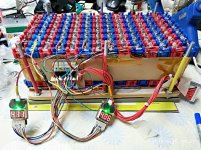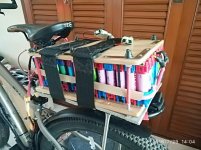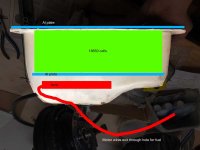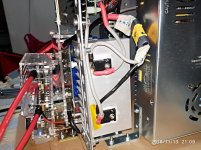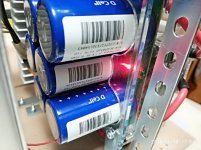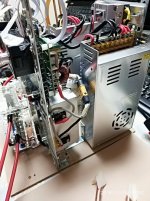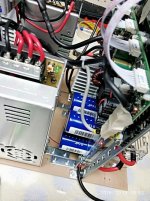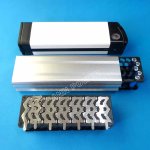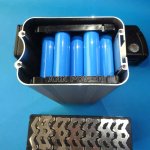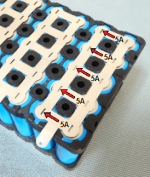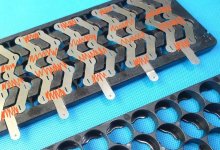ichiban
100 W
Guys,
I have a mission to climb a steep mountain 3,000+m rise & 60+km range after this build. So, I need some advices to prepare my new power pack...
I have ordered parts needed to DIY 14s7p (98 cells) pack using new LG18650 MJ1 (@3.4Ah ea./10A max) on my BBSHD & 27.5" MTB. This will be my very 1st spot-welding pack (but not the last). Cell holders will be the narrow type as shown. Dont like the airflow of it though. But not much choice, it is hard to squeeze 98 cells into my rather small bike triangle. I want to have this pack power me (65kgs) with the bike (30kgs) up high steep mountain (60+km / 3,000+m. elevation rise). This pack alone might nor be ennough, I will have a second 14s5p of same LG MJ1 on it, parallel with the 1st 14s7p.
I need advices & comments to accomplish all these :
1) My layout of the triangle pack 14S7P. Some narrow nickel might need to manually solder with copper braid that connect between p group (like the +10s to -11s group in the picture). I plan to use 0.3mm pure nickel & kWeld or the 0.2mm nickel will be fine ?
0.3mm x 36mm 99.96% Pure Nickel Plate Strap Strip Sheets pure nickel for Battery electrode Spot Welding Machine 18650 nickel US $70.00
https://www.aliexpress.com/item/0-3mm-x-36mm-99-96-Pure-Nickel-Plate-Strap-Strip-Sheets-pure-nickel-for-Battery/32850367866.html?spm=a2g0s.13010208.99999999.287.2b0f3c00hxUBKk
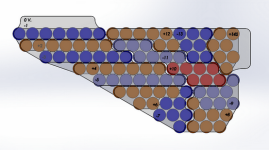
View attachment 3
The semi-transparent shade from of the pack are the intended nickel tabs. I color-label each cell into colors, red/orange = + and blue/light blue= -. Cells also divided into groups of 7-parallel. 1s, 2s, ..., 14s and vice versa. Should be clear enough.
View attachment 2
Re cut-out slit on nickel. Made a punch from steel pipe. Not perfect but should do the job in one punch for each slit. Hv not tried out yet & need to harden the steel pipe & sharpen. Easy & primitive, quick & cheap. LOL. Donot even have to go to laser shop.
View attachment 1
2) Do I need individual fuse for each cell ? Plan to use none.
3) Need a good BMS with bluetooth, preferable. My old BMS with my old salvaged laptop cells (also 14s7p with slip-on Vruzend caps) did not do a good job to my expectation. Slow balancing (daysss, if even balancing at all) and just cut power off during ride without even a small warning at all. Left me frustrated in the middle of the road several times already.
I ordered 1 of this, 60A & bluetooth + pc port, but have not tried it out yet. Anyone have good experience with it ? Any precautions ?
14S Smart Li-ion Battery PCB board Bluetooth Mobile BMS for 48V 58.8VLi-Ion E-bike Battery system with 20A to 60A Current US $47.24 / piece
https://www.aliexpress.com/item/14S-Smart-Li-ion-Battery-PCB-board-Bluetooth-Mobile-BMS-for-48V-58-8VLi-Ion/32794186005.html?spm=a2g0s.9042311.0.0.27424c4dACoIBE
Thanks a bunch. Any help will be greatly appreciated.
I have a mission to climb a steep mountain 3,000+m rise & 60+km range after this build. So, I need some advices to prepare my new power pack...
I have ordered parts needed to DIY 14s7p (98 cells) pack using new LG18650 MJ1 (@3.4Ah ea./10A max) on my BBSHD & 27.5" MTB. This will be my very 1st spot-welding pack (but not the last). Cell holders will be the narrow type as shown. Dont like the airflow of it though. But not much choice, it is hard to squeeze 98 cells into my rather small bike triangle. I want to have this pack power me (65kgs) with the bike (30kgs) up high steep mountain (60+km / 3,000+m. elevation rise). This pack alone might nor be ennough, I will have a second 14s5p of same LG MJ1 on it, parallel with the 1st 14s7p.
I need advices & comments to accomplish all these :
1) My layout of the triangle pack 14S7P. Some narrow nickel might need to manually solder with copper braid that connect between p group (like the +10s to -11s group in the picture). I plan to use 0.3mm pure nickel & kWeld or the 0.2mm nickel will be fine ?
0.3mm x 36mm 99.96% Pure Nickel Plate Strap Strip Sheets pure nickel for Battery electrode Spot Welding Machine 18650 nickel US $70.00
https://www.aliexpress.com/item/0-3mm-x-36mm-99-96-Pure-Nickel-Plate-Strap-Strip-Sheets-pure-nickel-for-Battery/32850367866.html?spm=a2g0s.13010208.99999999.287.2b0f3c00hxUBKk

View attachment 3
The semi-transparent shade from of the pack are the intended nickel tabs. I color-label each cell into colors, red/orange = + and blue/light blue= -. Cells also divided into groups of 7-parallel. 1s, 2s, ..., 14s and vice versa. Should be clear enough.
View attachment 2
Re cut-out slit on nickel. Made a punch from steel pipe. Not perfect but should do the job in one punch for each slit. Hv not tried out yet & need to harden the steel pipe & sharpen. Easy & primitive, quick & cheap. LOL. Donot even have to go to laser shop.
View attachment 1
2) Do I need individual fuse for each cell ? Plan to use none.
3) Need a good BMS with bluetooth, preferable. My old BMS with my old salvaged laptop cells (also 14s7p with slip-on Vruzend caps) did not do a good job to my expectation. Slow balancing (daysss, if even balancing at all) and just cut power off during ride without even a small warning at all. Left me frustrated in the middle of the road several times already.
I ordered 1 of this, 60A & bluetooth + pc port, but have not tried it out yet. Anyone have good experience with it ? Any precautions ?
14S Smart Li-ion Battery PCB board Bluetooth Mobile BMS for 48V 58.8VLi-Ion E-bike Battery system with 20A to 60A Current US $47.24 / piece
https://www.aliexpress.com/item/14S-Smart-Li-ion-Battery-PCB-board-Bluetooth-Mobile-BMS-for-48V-58-8VLi-Ion/32794186005.html?spm=a2g0s.9042311.0.0.27424c4dACoIBE
Thanks a bunch. Any help will be greatly appreciated.


